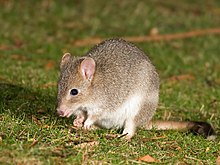
The broad-faced potoroo is an extinct potoroid marsupial that was found in southwestern Australia. The first specimen was collected in 1839, and described by John Gould in 1844. Only a small number of specimens have been collected since. The last live capture was in 1875. Subfossil remains indicate that it had an extensive distribution around the semiarid coastal districts of Southwest Australia.
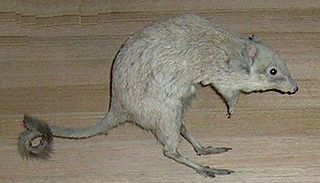
Potoroidae is a family of marsupials, small Australian animals known as bettongs, potoroos, and rat-kangaroos. All are rabbit-sized, brown, jumping marsupials and resemble a large rodent or a very small wallaby.

Australidelphia is the superorder that contains roughly three-quarters of all marsupials, including all those native to Australasia and a single species — the monito del monte — from South America. All other American marsupials are members of the Ameridelphia. Analysis of retrotransposon insertion sites in the nuclear DNA of a variety of marsupials has shown that the South American monito del monte's lineage is the most basal of the superorder.
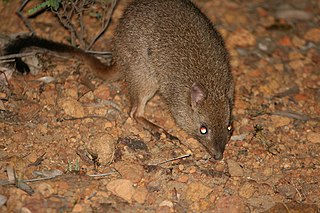
The woylie or brush-tailed bettong is a small, critically endangered mammal native to forests and shrubland of Australia. A member of the rat-kangaroo family (Potoroidae), it moves by hopping and is active at night, digging for fungi to eat. It is also a marsupial and carries its young in a pouch. Once widespread, the woylie mostly died out from habitat loss and introduced predators such as foxes. It is currently restricted to two small areas in Western Australia. There were two subspecies: B. p. ogilbyi in the west, and the now-extinct B. p. penicillata in the southeast.

The eastern bettong, also known as the southern or Tasmanian bettong, is a small, hopping, rat-like mammal native to grassy forests of southeastern Australia and Tasmania. A member of the rat-kangaroo family (Potoroidae), it is active at night and feeds on fungi and plant roots. Like most marsupials, it carries its young in a pouch. The eastern bettong is under pressure by introduced predators and habitat loss. The subspecies on mainland Australia is extinct, but populations of the Tasmanian subspecies have been reintroduced there.

The musky rat-kangaroo is a small marsupial found only in the rainforests of northeastern Australia. First described in the later 19th century, the only other species are known from fossil specimens. They are similar in appearance to potoroos and bettongs, but are not as closely related. Their omnivorous diet is known to include materials such as fruit and fungi, as well as small animals such as insects and other invertebrates.

The northern bettong is a small, endangered, gerbil-like mammal native to forests in northeast Australia. A member of the rat-kangaroo family (Potoroidae), it moves by hopping and lives in burrows, feeding at night on roots and fungi. It is also a marsupial and carries its young in a pouch. The northern bettong is threatened by habitat loss, and is now restricted to a few small areas.

Palorchestes is an extinct genus of large terrestrial, herbivorous Australian marsupial of the family Palorchestidae, living from the Miocene through to the Late Pleistocene. Like other palorchestids, it had highly retracted nasal region suggesting that it had a prehensile lip, as well as highly unusual clawed forelimbs that were used to grasp vegetation.

Potoroo is a common name for species of Potorous, a genus of smaller marsupials. They are allied to the Macropodiformes, the suborder of kangaroo, wallaby, and other rat-kangaroo genera. All three extant species are threatened by ecological changes since the colonisation of Australia, especially the long-footed potoroo Potorous longipes (endangered) and P. gilbertii. The broad-faced potoroo P. platyops disappeared after its first description in the 19th century. The main threats are predation by introduced species and habitat loss.
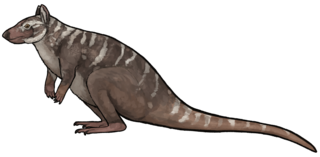
Ekaltadeta is an extinct genus of marsupials related to the modern musky rat-kangaroos. Ekaltadeta was present in what is today the Riversleigh formations in Northern Queensland from the Late Oligocene to the Miocene, and the genus includes three species. The genus is hypothesized to have been either exclusively carnivorous, or omnivorous with a fondness for meat, based on the chewing teeth found in fossils. This conclusion is based mainly on the size and shape of a large buzz-saw-shaped cheek-tooth, the adult third premolar, which is common to all Ekaltadeta.
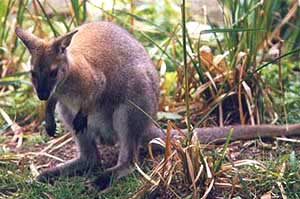
The Macropodiformes, also known as macropods, are one of the three suborders of the large marsupial order Diprotodontia. They may in fact be nested within one of the suborders, Phalangeriformes. Kangaroos, wallabies and allies, bettongs, potoroos and rat kangaroos are all members of this suborder.

The boodie, also known as the burrowing bettong or Lesueur's rat-kangaroo, is a small, furry, rat-like mammal native to Australia. Once common throughout the continent, it is now restricted to a few coastal islands. A member of the rat-kangaroo family (Potoroidae), it lives in burrows and is active at night when it forages for fungi, roots, and other plant matter. It is about the size of a rabbit and, like most marsupials, carries its young in a pouch.

The rufous rat-kangaroo or rufous bettong is a small, jumping, rat-like marsupial native to eastern Australia. It is the only species in the genus Aepyprymnus. The largest member of the potoroo/bettong family (Potoroidae), it is about the size of a rabbit. The rufous rat-kangaroo is active at night when it digs for plant roots and fungi, and like other marsupials it carries its young in a pouch. Though its range is reduced, the population is healthy and stable.
The Nullarbor dwarf bettong, Bettongia pusilla, was a potoroine marsupial that occurred in Australia. The animal is only known from skeletons found in caves of the Nullarbor Plain and is now classified as recently extinct.
The Macropodidae are an extant family of marsupial with the distinction of the ability to move bipedally on the hind legs, sometimes by jumping, as well as quadrupedally. They are herbivores, but some fossil genera like Ekaltadeta are hypothesised to have been carnivores. The taxonomic affiliations within the family and with other groups of marsupials is still in flux. Macropodids are considered to be the most diverse group of marsupial herbivores ever to have evolved, and have been the subject of more phylogenetic studies than any other marsupial family.
Bettongia anhydra, also known as desert bettong, is a recently extinct species of potoroine marsupial.
